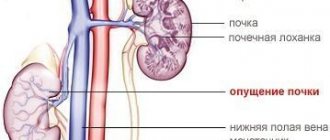Classification
The types of lung tumors are classified according to the location of the primary focus.
Central cancer is localized in the proximal (central) parts of the bronchial tree. The first signs of lung cancer (symptoms), which should alert you, in this case are clearly expressed:
- dry, prolonged cough that cannot be treated.
- hemoptysis begins with the addition of sputum.
- blockage of the bronchial lumen by tumor masses leads to shortness of breath even at rest. In some cases, the temperature may rise.
Photo 1 - Central cancer of the right lower lobe bronchus (1) with obstruction and metastases (2) to the bifurcation lymph nodes
Peripheral cancer gradually forms in the lateral parts of the lungs, slowly germinating and not detecting itself. This lung tumor may not produce symptoms for a long time; they appear with significant local spread, involvement of neighboring organs and structures, and invasion of the bronchi. Diagnosis of lung cancer of this type of localization is most often possible during a preventive examination (x-ray or computed tomography).
Photo 2 - Peripheral cancer (1) of the upper lobe of the right lung
Unusual signs of lung cancer
How does lung cancer manifest itself? Sometimes paraneoplastic syndromes occur with lung cancer. They are accompanied by pronounced electrolyte and metabolic disturbances, which lead to an increase in the concentration of calcium in the blood, a decrease in the level of potassium and sodium, and a shift in the acid-base balance to the acidic side.
If a cancerous tumor in the lungs produces excessive amounts of adrenocorticotropic hormone (ACTH), patients experience severe muscle weakness, edema, increased blood pressure, and edema. Sometimes hypercortisolism syndrome is accompanied by increased pigmentation.
Surgical method for treating lung cancer
- the main radical method for stages 1-3 of the disease. Operations performed for this disease are classified:
- by volume of resection (lobectomy (removal of a lobe of the lung), bilobectomy (removal of two lobes of the lung), pneumonectomy (removal of the entire lung)),
Photo 3 - Lobectomy
Photo 4 - Pneumonectomy
- by volume of removal of lymph nodes of the thoracic cavity (standard, expanded, super-expanded),
- by the presence of resection of adjacent organs and structures (combined operations are performed when the tumor grows into the pericardium, trachea, superior vena cava, esophagus, aorta, atrium, chest wall, spine). In addition to surgical treatment, it is possible to use an integrated approach, including radiation and chemotherapy.
When treating locally advanced malignant tumors with transition to the main bronchus and pulmonary artery, in cases where previously the only option for surgical treatment was pneumonectomy, it is now possible to perform organ-preserving operations. In this case, the affected area of the main bronchus is excised, followed by restoration of continuity (bronchoplastic and angioplastic lobectomies)
Photo 5 - Scheme of upper bronchoplastic lobectomy
How to start treatment in Israel?
To undergo cancer treatment in Israel, you need to contact the oncology center by calling +7-495-777-6953 or +972-3-376-03-58. You can also leave a request on the website by filling out the required fields. Our consultants will call you back within 2 hours.
Soon you will receive a lung cancer treatment plan in Israel with an upfront price. The preparation of this document does not oblige you to any action and is completely free. In addition, we guarantee the confidentiality of all information provided and compliance with medical etiquette.
Radiation therapy for lung cancer
Today, such modern methods of radiotherapy as IMRT (radiation therapy with the possibility of changing the radiation dose), 3D conformal radiation therapy (three-dimensional computer planning of selective irradiation) and stereotactic (precisely focused) radiation therapy are being actively implemented. In addition to oncologists, medical physicists, radiologists, dosimetrist physicists and other specialists participate in these manipulations.
Method shown:
- patients with a resectable lung tumor for whom surgical treatment cannot be performed due to contraindications from the cardiovascular system or for other reasons;
- as an alternative to surgery;
- to reduce the risk of relapse in case of damage to the mediastinal lymph nodes, a positive resection margin according to histological examination.
1st symptom – persistent cough
The first sign is a persistent cough. Pay attention to how you cough. If the cough goes away after one or two weeks, it means it was the result of a respiratory infection or cold. However, if the symptom does not disappear even after two weeks, it may indicate the development of lung cancer. A cough with mucus is a mandatory reason to see a doctor and undergo appropriate examinations of the lungs and chest - for example, an x-ray. A hoarse or bloody cough, as well as the discharge of a large amount of mucus, are very alarming signs and you should consult a doctor immediately. In such cases, we advise you to undergo examination by Israeli doctors.
Chemotherapy
Planning the course of treatment for non-small cell lung cancer includes the use of pharmacological agents. It is used for prevention purposes: adjuvant (auxiliary), postoperative chemotherapy for stages 2-3 of the disease and in the therapeutic course.
Depending on the histological type of tumor, stage of the disease and expected sensitivity to effects, various regimens for the use of chemotherapy have been developed.
Targeted therapy (eng. target - target, goal)
A separate type of pharmacological treatment, which consists in prescribing inhibitor drugs that act only on tumor cells in which various disorders have been identified, delaying or even blocking further growth.
- Tyrosine kinase inhibitors (gefitinib, erlotinib, afatinib) are used in the treatment of patients whose tumor tissue has mutations in the EGFR gene.
- If the EGFR mutation status is negative, use ALK inhibitors (crizotinib, alectinib).
There are targeted drugs, the prescription of which does not require the identification of any abnormalities in tumor cells. These include bevacizumab (VEGF inhibitor), nivolumab and pembrolizumab (anti-PDL1 antibodies).
Rehabilitation
After complex and long-term treatment, the patient often requires rehabilitation, which is most successful under the supervision of doctors and includes:
- anesthesia;
- drug therapy to accelerate tissue regeneration;
- physiotherapeutic procedures;
- physical therapy to restore physical activity;
- psychotherapeutic treatment.
As a result, the patient is completely restored to normal life and overcomes the consequences of the disease.
Life forecast
The prognosis of lung cancer in NSCLC includes symptoms, tumor size (> 3 cm), non-squamous histology, extent of spread (stage), lymph node metastasis and vascular invasion. Inoperability of the disease, severe symptoms and weight loss of more than 10% give lower results. Prognostic factors for small cell lung cancer include condition status, sex, stage of disease, and involvement of the central nervous system or liver at the time of diagnosis.
For non-small cell lung cancer, the prognosis for life with complete surgical resection of stage IA (early stage of the disease) is 70% five-year survival.
Causes and risk factors
Among the main causes of lung cancer, oncologists identify the following factors.
- Smoking tobacco. The most important and significant factor that increases the incidence of lung cancer symptoms in women by 22 times, and in men by 12 times compared to non-smokers.
- Genetic predisposition. A hereditary factor significantly increases the risk of developing a tumor.
- Polluted environment and harmful working conditions. Asbestos or coal dust, the presence of arsenic, chromium, nickel and other chemical compounds in the air provoke the development of neoplasms in the tissues of the respiratory organs.
- Radioactive radiation.
- Chronic lung diseases.
Diet
Diet for cancer
- Efficacy: no data
- Duration: until recovery or lifelong
- Groceries cost: 2500 - 4800 per week
It is important for patients to provide not only timely treatment, but also proper nutrition for lung cancer. After all, nutrition is an important factor in the treatment and recovery of the patient.
If you have cancer, you should maintain a healthy weight, eat a variety of foods with the right amount of nutrients, and avoid foods that may adversely affect your overall health.
For lung pathologies, it is recommended to introduce the following products into the diet:
- Dairy products.
- Stewed and boiled vegetables.
- White bread, pasta, crackers.
- Oatmeal, rice.
- Poultry, lean fish.
- Eggs.
- Butter.
- Soups and low-fat broths.
- Vegetable and fruit juices.
It is recommended to exclude the following foods from your diet:
- Any products with preservatives.
- Fatty dishes.
- Dishes high in sugar.
- Refractory cheeses.
It is very important to properly formulate the diet for those undergoing chemotherapy. The doctor will give individual recommendations regarding nutrition in such a situation. The general rules are as follows:
- It is recommended to eat in small portions.
- The basis of the menu should be liquid dishes, purees, and foods that are easily digested. This is relevant for nausea and problems with swallowing.
- Food should be eaten warm.
- It is recommended to drink tea with ginger and mint if you are worried about intestinal disorders.
- To prevent constipation, you need to regularly eat foods with fiber.
- Any food should be washed very thoroughly before cooking.
- Proper heat treatment of all products is important, since in patients after chemotherapy the immune system is not active enough, and there is a risk of infection by pathogens.
Causes of the disease
The root cause of the development of the oncological process is a change in DNA under the influence of toxic substances. These may be carcinogens from tobacco smoke inhaled during active or passive smoking. An important reason is working in hazardous industries. At increased risk are miners, workers in phosphate and metallurgical production, where people inhale dust and toxic chemicals.
Factors that provoke the occurrence of oncology are:
- Tuberculosis.
- Burdened heredity.
- Chronic diseases of the bronchopulmonary system.
- Chest injuries.
The following stages of lung cancer are distinguished:
Stage I – neoplasm up to 3 cm in volume. Located in one segment of the lung. There are no metastases.
Stage II – tumor size less than 6 cm. Metastases are present only in the pulmonary and bronchopulmonary lymph nodes.
Stage III - the tumor grows into the adjacent lobe of the lung or into the adjacent bronchus. Metastases are located in bifurcation, tracheobronchial, paratracheal lymph nodes.
Stage IV - the neoplasm spreads to nearby organs, inflammation of the pleura and/or pericardium occurs. The terminal stage is characterized by both local and distant metastases.
Consequences and complications
Complications from neoplasms can develop both in the lungs and in other organs.
The following may develop as pulmonary complications:
- pneumonia;
- bronchitis;
- pulmonary hemorrhage.
The following pathologies are possible as non-pulmonary complications:
- pleural effusion;
- neuropathy;
- joint pain;
- pericarditis;
- blockage of the esophagus, respiratory tract;
- thrombosis;
- tumor cachexia .
The risk of developing a relapse of the process depends on both the localization and the prevalence of the pathology. Its likelihood increases due to improper or untimely treatment.
Features of treatment at different stages
Stage 1
Surgery is the preferred treatment for stage 1a-1b non-small cell lung cancer (NSCLC). Careful assessment of residual pulmonary reserve should be performed as part of surgical planning. Lobectomy is often considered the optimal procedure, but patients with limited pulmonary reserve may be considered for a more limited procedure with segmental or wedge resection. It has long been thought that the risk of local recurrence is higher with limited resection, but in a randomized trial conducted by the European Lung Cancer Study Group, there was no adverse effect on overall survival.
In Belgium, video-assisted thoracoscopic surgery (VATS) is widely used in early stages, reducing post-operative recovery time and reducing post-operative morbidity.
Patients with insufficient pulmonary reserve to undergo resection can be treated with radiation therapy alone with curative intent. Retrospective data suggest a 5-year survival rate of 10-25% with radiation therapy alone in this setting. Selected patients may be candidates for either stereotactic body radiotherapy or radiofrequency ablation for isolated lesions.
Adjuvant chemotherapy with tandem carboplatin-paclitaxel provided improved overall survival at 4 years (71% vs. 59%), but longer follow-up at 74 months showed no change in overall survival except in patients with tumor size greater than 4 cm.
Stage 2
Surgical resection is the treatment of choice for this stage, except in those patients who are not surgical candidates due to underlying conditions or poor pulmonary reserve.
For patients receiving radiation therapy alone, long-term survival is 10-25%. In such cases, however, the radiation dose should be approximately 60 Gy, with careful planning to determine tumor volume and avoid critical structures.
Patients with resected stage II disease are candidates for adjuvant platinum-based chemotherapy and should be offered four cycles of adjuvant platinum-based chemotherapy.
Stage 3A
A large randomized trial conducted by the European Organization for Research and Treatment of Cancer (EORTC) compared surgery and radiotherapy after neoadjuvant chemotherapy and found no significant difference between the two approaches in stage 3A N2 disease. However, neoadjuvant chemotherapy followed by surgery may be considered for younger patients with stage 3A disease who have good performance status.
Patients with stage 3 (T3-4, N1) superior sulcus disease are typically treated with neoadjuvant chemotherapy followed by surgical resection. The two-year survival rate in this group is 50-70%.
In Belgium, patients with stage 3A (T3, N1) disease are increasingly receiving targeted and immunotherapy as first-line treatment. Chemotherapy regimens and regimens using radiation therapy are relegated to the background due to their lower effectiveness.
Stage 3B
Patients with stage 3B disease are generally not candidates for surgical resection and are best treated with targeted therapy or immunotherapy (sometimes in combination with chemoradiotherapy).
In an open-label phase III trial in patients with stage 3B NSCLC, cetuximab in combination with chemotherapy (taxane/carboplatin) achieved a statistically significant improvement in overall response rate.
A meta-analysis of 10 randomized trials of combination chemoradiation therapy found a 10% reduction in the risk of death with combination modality therapy compared with radiation alone. It appears that in appropriate candidates (with good performance status), chemotherapy given concurrently with radiation results in improved survival compared with chemotherapy followed by radiation.
Patients with stage 3B NSCLC and poor performance status are not candidates for chemotherapy or a combination approach. These patients may benefit from radiation therapy alone to relieve symptoms of shortness of breath, cough, and hemoptysis.
Patients with invasive airway obstruction may be candidates for palliative endobronchial curettage or stenting to relieve obstructive atelectasis and dyspnea.
Stage 4
Patients with advanced NSCLC should be evaluated for distant metastases. Patients with solitary brain lesions may benefit from surgical resection or stereotactic radiosurgery if their underlying disease is well controlled.
In a small study, patients with isolated adrenal metastases treated with surgical adrenal resection had significantly better 5-year survival compared with nonoperative treatment—34% versus 0%.
Patients with nonsquamous histology, absence of cranial metastases, and absence of hemoptysis may be candidates for treatment with bevacizumab, which has been studied in combination with carboplatin-paclitaxel and cisplatin-gemcitabine.
Small molecule EGFR tyrosine kinase inhibitors, such as gefitinib and erlotinib, may be useful for nonsmokers with adenocarcinomas, especially bronchoalveolar carcinoma. In such patients, it may be useful to evaluate for EGFR mutations and use these first-line agents.
Likewise, patients with EGFR expression and no KRAS mutations may be considered for the addition of cetuximab to first-line chemotherapy.
Recommendations of the European Society of Clinical Oncology (ESMO) on chemotherapy for stage 4
First line therapy
- Platinum doublet therapy (bevacizumab can be added to carboplatin plus paclitaxel if there are no contraindications).
- Afatinib, erlotinib, or gefitinib for patients with EGFR mutations.
- Crizotinib for patients with ALK or ROS1 gene rearrangements.
- Other recommended first-line regimens or platinum plus etoposide for patients with large cell neuroendocrine carcinoma.
Maintenance therapy
- Continue pemetrexed in patients with stable disease or response to first-line pemetrexed-containing regimens.
- Alternative chemotherapy.
- Chemotherapy break.
Second line therapy
- Docetaxel, erlotinib, gefitinib, or pemetrexed for patients with nonsquamous cell carcinoma.
- Docetaxel, erlotinib, or gefitinib for patients with squamous cell carcinoma.
- Chemotherapy or ceritinib for patients with ALC rearrangement who progress after crizotinib.
Third line therapy
- Treatment with erlotinib for patients who have not received erlotinib or gefitinib.
Patients with large cell neuroendocrine carcinoma should receive platinum plus etoposide or the same treatment as other patients with nonsquamous carcinoma.











